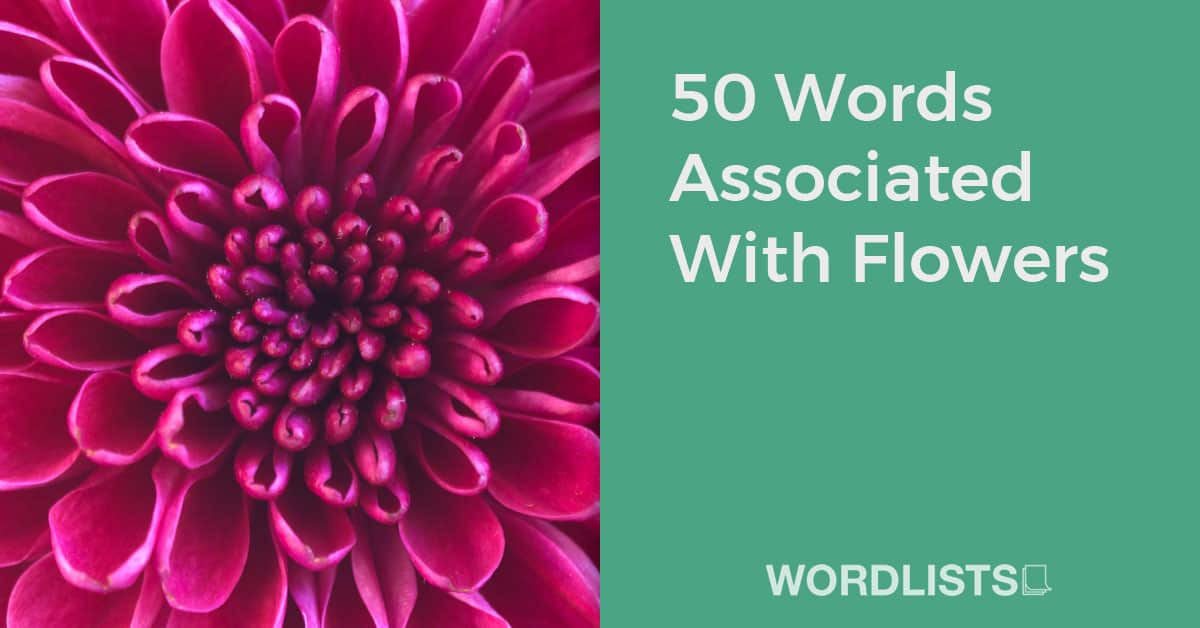Flowers are a beautiful and integral part of the natural world, and they have long been associated with a wide range of meanings and symbolism. From the delicate petals of a rose to the vibrant blooms of a sunflower, flowers have inspired poets, artists, and writers for centuries.
In this list, we explore 50 words associated with flowers, covering everything from the physical characteristics of flowers to their cultural and symbolic significance. Whether you are a budding botanist or simply appreciate the beauty of flowers, this article is sure to have something of interest to you.

Subscribe to our mailing list to receive FREE exclusive content and offers!
50 Words Associated With Flowers Meanings
Rose: A flower from the Rosaceae family, known for its showy, often fragrant blooms. Roses come in many different colors and varieties, symbolizing different things in various cultures.
Lily: A large, often fragrant flower from the Liliaceae family, characterized by its large, trumpet-shaped blossoms and long, slender stem.
Daisy: A common garden flower known for its circular shape with a yellow center and white petals, although they come in various colors. The name “daisy” comes from “day’s eye,” because the flower opens in the morning and closes at night.
Sunflower: A large, bright yellow flower known for its tall stem and large head that resembles the sun. Sunflowers are known for their seeds, which can be roasted and eaten or used to produce oil.
Tulip: A bulbous spring-flowering plant with brightly colored cup-shaped flowers. Tulips are native to Asia and North Africa but are most widely associated with Holland.
Orchid: A diverse and widespread family of flowering plants with blooms that are often colorful and fragrant. Orchids are known for their complex flower structures and their ecological interactions with pollinators and fungi.
Peony: A flowering plant known for its large, fragrant flowers that come in various colors including pink, red, and white. Peonies are native to Asia, Europe, and Western North America.
Iris: A flowering plant with showy flowers, which can be found in a wide variety of colors. The name comes from the Greek word for rainbow, referring to the wide variety of flower colors found among the many species.
Daffodil: A spring-flowering plant with yellow or white flowers and a central trumpet-shaped corona. Daffodils are associated with spring and renewal.
Marigold: A common flower characterized by its vibrant orange color. Marigolds are often planted in vegetable gardens because they deter certain pests.
Chrysanthemum: A flower known for its colorful, pom-pom-like blooms. Chrysanthemums are native to Asia and northeastern Europe and come in a variety of colors.
Gladiolus: A flower characterized by its tall, pointed shape with multiple flowers along the stem. The flower gets its name from the Latin word for sword and is also known as the “sword lily.”
Larkspur: A plant with tall, spiked flowers that come in various colors, including blue, pink, and white. Larkspur is often associated with lightness and levity.
Poinsettia: A plant known for its red and green foliage often associated with Christmas. The plant’s association with Christmas comes from a Mexican legend about a girl who could only offer weeds as a gift to Jesus on Christmas Eve.
Hibiscus: A flowering plant that produces large, colorful, trumpet-shaped flowers. Hibiscus flowers are often associated with tropical climates.
Dahlia: A tuberous plant known for its bright, large, and complex flowers. Dahlias come in many sizes and colors, except for blue.
Freesia: A fragrant flowering plant often used in bouquets or as cut flowers. Freesias come in a variety of colors and are native to Africa.
Zinnia: A genus of plants known for their bright, daisy-like flowers. Zinnias are popular in summer gardens and are especially beloved by butterflies.
Petunia: A plant known for its wide variety of bright colors and its funnel-shaped flowers. Petunias are popular plants for summer gardens.
Viola: A type of flowering plant with small, typically purple flowers. Violas include pansies and violets among their number.
Pansy: A type of large-flowered hybrid plant cultivated as garden flowers. Pansies are derived from the wildflower Viola and come in many colors.
Geranium: A common bedding plant known for its bright, round flowers and lobed leaves. Geraniums are popular for their ease of care and their variety of colors.
Cosmos: A type of flower known for its colorful, daisy-like flowers on slender stems. Cosmos are often planted in sunny gardens and attract a variety of butterflies.
Calendula: A plant also known as pot marigold, it produces bright orange or yellow flowers. Calendula is often used in herbal remedies and skin care products.
Foxglove: A tall plant with a spike of bell-shaped flowers that are typically patterned and tubular. Foxgloves are known to attract bees.
Heliotrope: A plant known for its sweet vanilla scent and its clusters of white, lavender, or purple flowers. Heliotropes are a popular choice for both gardens and bouquets.
Hyacinth: A bulbous plant with a cluster of fragrant flowers that appear in the spring. Hyacinths come in a range of colors, including white, peach, orange, salmon, yellow, pink, red, purple, lavender and blue.
Lavender: A plant known for its purple flowers and soothing fragrance. Lavender is often used in aromatherapy and in a variety of beauty products.
Violets: A type of flowering plant with typically purple or blue small, delicate flowers. Violets are often associated with purity and modesty.
Asters: A genus of flowering plants with star-shaped flowers, hence their name from the Greek word for “star.” Asters come in many colors, including blue, white and pink.
Bachelor’s Buttons: Also known as cornflowers, they are known for their bright blue flowers. They have been used historically in both cooking and medicine.
Bluebells: A type of flower known for their bright blue, bell-shaped flowers that droop or “nod” from the stem. Bluebells are often associated with gratitude.
Buttercups: A type of flowering plant known for its bright yellow, cup-shaped flowers. Despite their charming appearance, buttercups are typically toxic when ingested by humans or animals.
Columbine: A flowering plant known for its distinctive, bell-shaped flowers and spurred petals. Columbines come in a variety of colors and are often found in woodland and meadow habitats.
Crocus: A flowering plant known for its brightly colored flowers that often bloom in early spring or fall. Crocuses are often planted as garden ornamentals.
Delphinium: A genus of flowering plants known for their tall spikes of colorful flowers. Delphiniums are often grown for their showy flowers, which come in a variety of colors.
Foxglove: A tall, striking plant with bell-shaped flowers arranged in a spike. The flowers are typically purple, but can also be white, yellow, or pink. Foxglove is known for its toxic properties and its use in heart medications.
Hollyhock: A flowering plant known for its tall spikes of large, colorful, disc-like flowers. Hollyhocks are often planted in cottage gardens and are associated with fertility and abundance.
Jonquil: A type of daffodil with clusters of small, fragrant, bright yellow flowers. Jonquils are often associated with affection and desire.
Lilac: A flowering woody plant known for its clusters of fragrant, light purple flowers. Lilacs symbolize first love and are often used in perfumes.
Nasturtium: A flowering plant with bright, trumpet-shaped flowers and round, water-repellent leaves. Nasturtiums are often grown as ornamental plants and are also edible, with a peppery taste.
Periwinkle: A plant known for its small, star-shaped, blue or white flowers. Periwinkle is often used as a ground cover in landscaping.
Primrose: A plant known for its bright, typically yellow, bell-shaped flowers. Primroses often bloom in early spring, symbolizing the arrival of the new season.
Snapdragon: A plant characterized by its tall stalks of colorful, uniquely shaped flowers that open and close when squeezed, resembling a dragon’s mouth.
Sweet Pea: A flowering plant known for its fragrant, butterfly-like flowers. Sweet peas are often grown on trellises and come in many colors.
Sweet William: A plant with clusters of small, brightly colored flowers. Sweet William is often planted in gardens for its ornamental value and pleasant fragrance.
Water Lily: An aquatic plant with large, round leaves and typically white, pink, or yellow flowers. Water lilies are often associated with rebirth and optimism.
Wisteria: A climbing vine known for its fragrant, drooping clusters of flowers, usually in shades of purple. Wisteria is often used in landscaping as a climbing vine.
Yarrow: A plant with clusters of small, white, pink, or yellow flowers. Yarrow is often associated with healing and has been used in herbal medicine.
Poppy: A plant with large, delicate, often red flowers and small, black seeds. Poppies are often associated with remembrance and are used in some cuisines.







